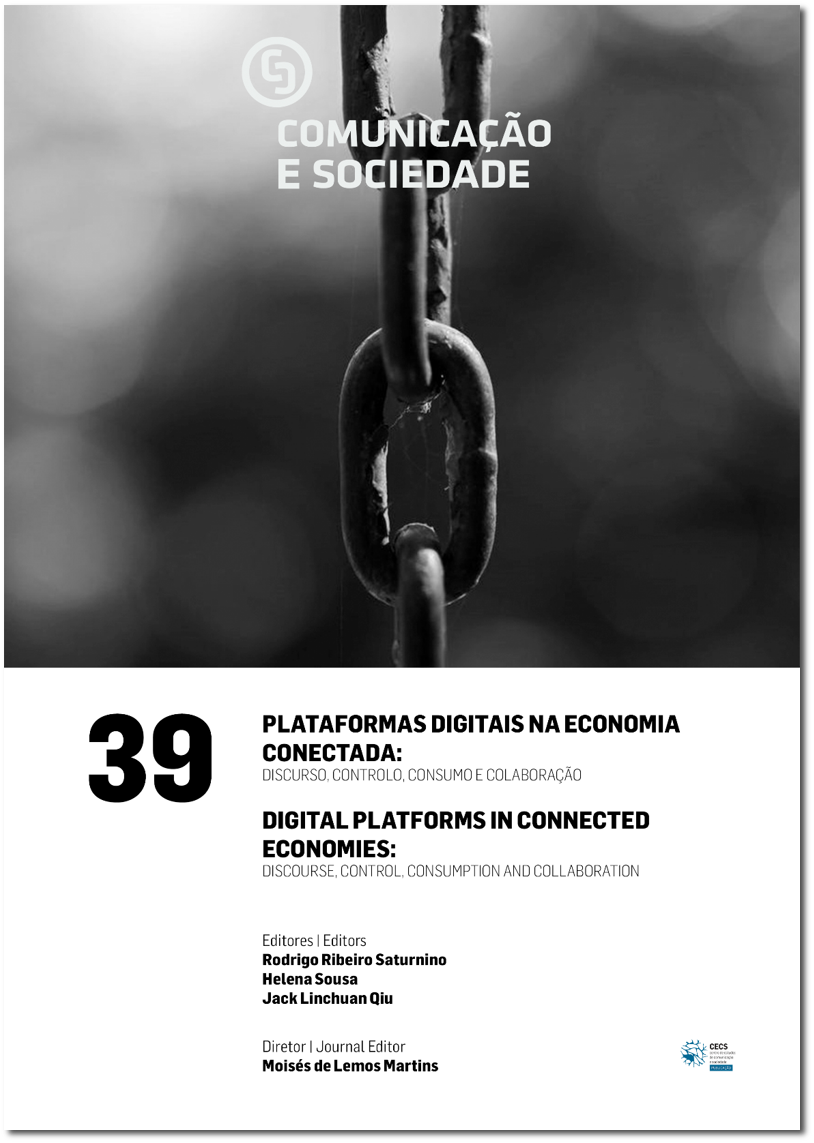Análise de Sentimentos: Da Psicométrica à Psicopolítica
DOI:
https://doi.org/10.17231/comsoc.39(2021).2797Palavras-chave:
emoções, análise de sentimentos, psicopolítica, big data, vigilânciaResumo
Os dados sobre nossas emoções, os chamados emotional data, constituem hoje uma valiosa commodity coletada e comercializada por plataformas de comunicação digital. Entre os maiores interessados em obtê-la estão corporações financeiras e políticas que, entre outros usos, baseiam suas decisões em informações sobre os afetos dos usuários das redes. Existem diferentes formas de se gerar emotional data, e uma delas é a análise de sentimentos. Este artigo aborda algumas características dessa ferramenta, investigando o seu funcionamento e os saberes psicométricos que a constituem. A análise de sentimentos é entendida não apenas como uma ferramenta de detecção de afetos, mas também de produção emocional, uma técnica que opera instrumentalizando as emoções para uma capitalização alheia ao indivíduo. É dessa maneira que é possível delineá-la — para além de um instrumento psicométrico — como um aparato psicopolítico. Neste sentido, conceitos como “sociedade de controle” (Deleuze, 1992), “sociedade confessional” (Bauman, 2012/2014), além da própria noção de “psicopolítica” (Han, 2014/2014b), são úteis para compreendermos aspectos da produção emocional assentes nas novas tecnologias da comunicação. Este artigo, portanto, pretende contribuir para o entendimento de um fator importante, mas ainda algo negligenciado nos estudos sobre big data e vigilância: o monitoramento e a produção de afetos como forma de controle subjetivo.
Downloads
Referências
Andrade, O. (2017). Manifesto Antropófago e outros textos. Companhia das Letras. (Original work published 1928)
Andrejevic, M. (2011). The work that affective economics does. Cultural Studies, 25(4–5), 604–620. https://doi.org/10.1080/09502386.2011.600551
Bauman, Z. (2014). Vigilância líquida: Diálogos com David Lyon (C. A. Medeiros, Trad.). Zahar. (Trabalho original publicado em 2012)
Bentham, J. (2019). O panóptico (T. Tadeu, Trad.). Autêntica. (Trabalho original publicado em 1791)
Bollen, J., Pepe, A., & Mao, H. (2011). Modeling public mood and emotion: Twitter sentiment and socio-economic phenomena. In L. Adamic, R. Baeza-Yates, & S. Counts (Eds.), Proceedings of the Fifth International AAAI Conference on Weblogs and Social Media (pp. 450–453). AAAI Press.
Bosco, C., Patti, V., & Bolioli, A. (2013). Developing corpora for sentiment analysis: The case of irony and senti-tut. IEEE Intelligent Systems, 28(2), 55–63. https://doi.org/10.1109/MIS.2013.28
Ceron, A., Curini, L., & Iacus, S. M. (2015). Using sentiment analysis to monitor electoral campaigns: Method matters - evidence from the United States and Italy. Social Science Computer Review, 33(1), 3–20. https://doi.org/10.1177/0894439314521983
Deleuze, G. (1992). Conversações (P. P. Pélbart, Trad.). Editora 34.
Deng, S., Sinha, A. P., & Zhao, H. (2017). Resolving ambiguity in sentiment classification: The role of dependency features. ACM Transactions on Management Information Systems (TMIS), 8(2–3), 1–13. https://doi.org/10.1145/3046684
Fathullah, A., & Willis, K. S. (2018). Engaging the senses: The potential of emotional data for participation in urban planning. Urban Science, 2(4), 98. https://doi.org/10.3390/urbansci2040098
Feitosa, C. (2018, 5 de outubro). Por uma psicopolítica de resistência. Cult. https://revistacult.uol.com.br/home/por-uma-psico-politica-de-resistencia/
Ferrara, E., & Yang, Z. (2015). Measuring emotional contagion in social media. PLOS ONE, 10(11),1–14. https://doi.org/10.1371/journal.pone.0142390
Foucault, M. (2014). Vigiar e punir: nascimento da prisão (P. E. Duarte, Trad.). Leya. (Trabalho original publicado em 1975)
Gomes, H. J. C. (2012). Text mining: Análise de sentimentos na classificação de notícias [Dissertação de mestrado, Universidade Nova de Lisboa]. Repositório da Universidade Nova de Lisboa. http://hdl.handle.net/10362/9182
Gonçalves, P., Dores, W., & Benevenuto F. (2012). PANAS-t: Uma escala psicométrica para medição de sentimentos no Twitter. In 1st Brazilian Workshop on Social Network Analysis and Mining (Brasnam). http://www2.sbc.org.br/csbc2012/anais_csbc/eventos/brasnam/artigos/BRASNAM%20-%20PANAS-t%20Uma%20Escala%20Psicometrica%20para%20Medicao%20de%20Sentimentos%20no%20Twitter.pdf
Haggerty, K. D., & Ericson R. V. (2000). The surveillant assemblage. British Journal of Sociology, 51(4), 605–622. https://doi.org/10.1080/00071310020015280
Han, B.-C. (2014a). A sociedade da transparência (M. S. Pereira, Trad.). Relógio d’Água. (Trabalho original publicado em 2012)
Han, B.-C. (2014b). Psicopolítica (M. S. Pereira Trad.). Relógio d’Água. (Trabalho original publicado em 2014)
Heins, M. (2013). The brave new world of social media censorship. Harvard Law Review, 127(8), 325–330. https://harvardlawreview.org/2014/06/the-brave-new-world-of-social-media-censorship/
Hernández-Farías, I., Benedí, J. M., & Rosso, P. (2015). Applying basic features from sentiment analysis for automatic irony detection. In R. Paredes, J. S. Cardoso, & X. M. Pardo (Eds.), 7th Iberian Conference on Pattern Recognition and Image Analysis (pp. 337–344). Springer. https://doi.org/10.1007/978-3-319-19390-8_38
Hintz, A. (2015). Social media censorship, privatized regulation and new restrictions to protest and dissent. In L. Dencik & O. Leistert (Eds.), Critical perspectives on social media and protest: Between control and emancipation (pp. 109–126). Rowman & Littlefield. http://orca.cf.ac.uk/id/eprint/87265
Hur, D. U. (2013). Da biopolítica à noopolítica: Contribuições de Deleuze. Lugar Comum, (40), 201–215.
Illouz, E. (2018). Emotions as commodities: Capitalism, consumption and authenticity. Routledge.
Islam, M. R. & Zibran, M. F. (2017). Leveraging automated sentiment analysis in software engineering. In 2017 IEEE/ACM 14th International Conference on Mining Software Repositories (MSR) (pp. 203–214). IEEE. https://doi.org/10.1109/MSR.2017.9
Khoo, C. S. & Johnkhan, S. B. (2018). Lexicon-based sentiment analysis: Comparative evaluation of six sentiment lexicons. Journal of Information Science, 44(4), 491–511. https://doi.org/10.1177/0165551517703514
Levin, S. (2017, 1 de maio). Facebook told advertisers it can identify teens feeling ‘insecure’ and ‘worthless’. The Guardian. https://www.theguardian.com/technology/2017/may/01/facebook-advertising-data-insecure-teens
Liu, B. (2012). Sentiment analysis and opinion mining. Morgan & Claypool Publishers. https://www.cs.uic.edu/~liub/FBS/SentimentAnalysis-and-OpinionMining.pdf
Luo, Z., Chen, J., Takiguchi, T., & Ariki, Y. (2017). Emotional voice conversion with adaptive scales F0 based on wavelet transform using limited amount of emotional data. In F. Lacerda, D. House, M. Heldner, J. Gustafson, S. Strömbergsson, & M. Włodarczak (Eds.), Interspeech 2017 (pp. 3399–3403). ISCA. http://www.me.cs.scitec.kobe-u.ac.jp/~takigu/pdf/2017/interspeech-luo.PDF
Malheiros, Y. (2014). Emotte: Uma ferramenta de análise de sentimentos para o Twitter. In XX Brazilian Symposium on Multimedia and the Web. Webmedia (pp. 62–65). Sociedade Brasileira de Computação. https://sol.sbc.org.br/index.php/webmedia_estendido/article/view/4932
Marques, R. O. (2019, 11 de junho). Projecto premiado que ajuda a prevenir suicídios passa por Braga. Meios e Publicidade. https://www.meiosepublicidade.pt/2019/06/projecto-premiado-ajuda-prevenir-suicidio-passa-braga-videos/.
Matsumae, A., Luo, R., Wang, Y., Nishimura, E., & Motomura, Y. (2020). Emotional data visualization for well-being, based on HRV analysis. In T. Ahram, W. Karwowski, A. Vergnano, F. Leali, & R. Taiar (Eds), International Conference on Intelligent Human Systems Integration (pp. 1270–1276). Springer. https://doi.org/10.1007/978-3-030-39512-4_194
McNair, D. M., Lon, M., & Droppelman, L. F. (1971). Manual for the profile of mood states. Educational and Industrial Testing Service.
Moise, C. (2017). Natural language processing in political Campaigns. In A. Dinu, P. Osenova, & C. Vertan (Eds.), Proceedings of the First Workshop on Language Technology for Digital Humanities in Central and (South-)Eastern Europe (pp. 39–43). Incoma.
Pasquali, L. (2017). Psicometria: Teoria dos testes na psicologia e na educação. Vozes.
Pasquinelli, M., & Joler, V. (2020). The Nooscope manifested: AI as instrument of knowledge extractivism. AI & society, 1–18. https://doi.org/10.1007/s00146-020-01097-6
Plutchik, R. (1980). A general psychoevolutionary theory of emotion. Academic Press.
Reason Why. (2019, 22 de maio). Code of Hope - Publicis España para Teléfono de la Esperanza [Vídeo]. YouTube. https://www.youtube.com/watch?v=AdSEEBfhPYw
Ringsquandl, M., & Petkovic, D. (2013). Analyzing political sentiment on Twitter. In M. desJardins & M. L. Littman (Eds.), 2013 AAAI Spring Symposium Series (pp. 40–47). AAAI.
Rolnik, S., & Guattari, F. (1986). Micropolítica: Cartografias do desejo. Vozes.
Silveira, S. A. (2015). Interações públicas, censura privada: O caso do Facebook. História, Ciências, Saúde – Manguinhos, 22, 1637–1651. http://doi.org/10.1590/S0104-59702015000500006
Spinoza, B. (2014). Carta 58 a Schuller. In R. Romano, N. Cunha, & J. Guinsburg (Eds.), Obra completa II (pp. 258–260). Perspectiva.
Stark, L. (2018). Algorithmic psychometrics and the scalable subject. Social Studies of Science, 48(2), 204–231. https://doi.org/10.1177/0306312718772094
Tiqqun (2020). The cybernetic hypothesis. Semiotext(e).
Watson, D., & Clark, A. (1994). Positive and negative affect schedule – Expanded form. The University of Iowa. https://doi.org/10.17077/48vt-m4t2
Downloads
Publicado
Como Citar
Edição
Secção
Licença
Direitos de Autor (c) 2021 Comunicação e Sociedade

Este trabalho encontra-se publicado com a Creative Commons Atribuição-NãoComercial 4.0.
Os autores são titulares dos direitos de autor, concedendo à revista o direito de primeira publicação. O trabalho é licenciado com uma Licença Creative Commons - Atribuição 4.0 Internacional.












